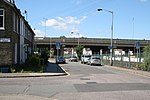Reeves Corner tram stop

Reeves Corner tram stop is a stop on the Tramlink service in central Croydon. It is normally only served by trams travelling eastbound from Wimbledon to Croydon; trams going in the opposite direction pass the station on the other side of the road without stopping. The complementary stop for westbound trams is Church Street tram stop. As of May 2019, redevelopment was taking place. Arcadia House, which adjoined the platform, had been demolished and was being replaced by a new high-rise structure known as 'Cairo'.The name is derived from House of Reeves, a furniture store established in 1867, one of whose buildings was destroyed in the 2011 England riots.
Excerpt from the Wikipedia article Reeves Corner tram stop (License: CC BY-SA 3.0, Authors, Images).Reeves Corner tram stop
Cairo New Road, London Broad Green (London Borough of Croydon)
Geographical coordinates (GPS) Address Nearby Places Show on map
Geographical coordinates (GPS)
| Latitude | Longitude |
|---|---|
| N 51.3748 ° | E -0.1063 ° |
Address
Cairo New Road
Cairo New Road
CR0 1GE London, Broad Green (London Borough of Croydon)
England, United Kingdom
Open on Google Maps











